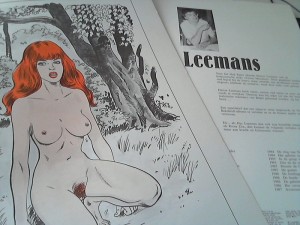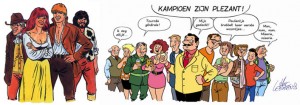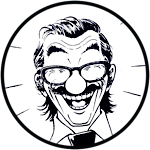
Hector (Hec) Leemans is a Flemish cartoonist and scenario writer who was ‘trained’ according to the press (but Hec Leemans says he just visited the studio one day and Bob de Moor gave him some very useful tips) by Bob de Moor as a 15-year old. Debuting with the series Circus Maximus, he hit the right spot when launching the Bakelandt series which debuted from October 20 1975 on in the newspapers Het Laatste Nieuws and De Nieuwe Gazet. After the death of scenario writer Daniël Jansens in 1980, Leemans took over the writing duties.

The last 20 albums were drawn by Claus Scholz while Leemans kept on providing the scenarios. In 2006 the series was paused after the 96th album, but by then Red Zita had become a muse for many male readers.
By 1990 he had also started 2 new series, Nino, drawn by Dirk Stallaert, and the shortlived Kowalsky. While Nino has become one of the best post-Hergé examples of how the clear line can be alive and kicking, it was with the comic series FC De Kampioenen, based on the TV series with the same name, that Leemans would reach a huge mass of young readers. He was also the one who co-wrote the immensely popular film of said TV series.
Hec knows the ins and outs of the Flemish comic scene, so a talk with him on Bob de Moor was on our shortlist for sure.
BDM: In the book “De klare lijn en de golven” there is a reference to a conflict that you have had with Bob de Moor concerning the continuation of “L’ Alphart”. What was it about? Did you minimize his input in Tintin?
HL: I never minimized Bob’s share in Tintin. The quote that irritated Bob was that I had said that I would find it legitimate that someone would draw “L’ Alphart” (Bob that is, who else?) if there was a complete scenario available. In there I also referred to a meeting I had with Hergé during which he showed me how he had put indications on his drafts for the decors. That’s all I said. I don’t know why Bob interpreted this as an attack on him personally, because I especially wanted to overhaul some critics in the press with my example. Fact is that at that moment he was under siege of several people, inside and outside the studio, who all wanted to interfere with “L’ Alphart”. I presume he worked his irritation out on me. I immediately called Bob and 14 days later he invited me for a meal in Brussels. End of story. We never had any quarrel since then. I have the utmost respect for the work that Bob did with Hergé.
BDM: Was he according to you capable – when given enough time (unlike the short deadline he got imposed for completing the Blake & Mortimer album “Mortimer vs. Mortimer”) – to complete “L’ Alphart”?
HL: If there had been a proper scenario, Bob surely could have completed it. But the work of Hergé was, especially scenario wise, rather personal. However, Bob once told me that he more or less knew in what direction Hergé wanted to head the story.
BDM: Bob de Moor risks to end up as a footnote in comic history as his work outside the studio is far less known. In a chat I had earlier last month with Merho, he told that Bob would end up being forgotten since he worked as a servant for Hergé, and that contrarily to Hergé and Vandersteen, he wasn’t really a born storyteller. A theory that isn’t completely correct according to me, the Cori stories for instance showcase that he was an excellent storyteller. What’s your take on this?
HL: History will tell us. An oeuvre can temporarily be forgotten, but find a public again a decennium later. Everything happens in cycles. I’m convinced that the children of Bob will do the necessary to keep his work in the spotlight, which they are actually busy with.
BDM: How would you describe Bob de Moor as human being?
HL: Bob was a fantastic person, a gentleman. He wasn’t fickle, was always friendly and full of humor. A few months before he got ill, he visited my place together with Jeanne, his wife. He offered to exchange a plate of Cori for a plate of Bakelandt. But alas, that never happened. A few months later I met Bob for the last time at a meeting at the Belgian Comic Centre. I knew it would be the last time that I would see him.
I recently remembered a rather funny anecdote with Bob. When the Belgian Comic Centre was opened he had to give a speech, being the chairman. The king and the queen were there and hundreds of invitees. He did his duty with a lot of aplomb in both dutch and french and ended his speech with “Vive le Centre Belge de la Bande Dessinee et viva boma, pattatten met saucissen!” I don’t know how many people heard that, but I did. Typically Bob.
(editor’s note: the “viva boma, pattatten met saucissen” line comes from a popular Antwerp song, but it became ‘cult’ when Gérard Madiata — and not Papa Wemba as so often said — sang the song for president Mobutu and a few Belgian ministers including Willy De Clerck and Leo Tindemans. The latter were on a mission in the former belgian colony of Zaire, which now is the Republique Démocratique du Congo. You can see the fragment here – note that the ministers had trouble not bursting out into laughter. The story would later also pop up in Nero’s “Beo the terrible” by Marc Sleen.)
BDM: Did you learn anything from him when it comes to drawing?
HL: Bob was the very first comic artist I met face to face when I was just 15 years old. Already during that first meeting he gave me some useful tips. I always remembered them: clarity for everything in your drawing.

BDM: Besides drawing the popular FC De Kampioenen (‘FC The Champions’ in english), you also co-wrote the scenario for the film on The Champions which became a huge succes in the theaters. Any idea why the film “W” by that other popular series “Witse” turned out to be a huge flop?
HL: I guess that it has something to do with the fact that the Witse character in the movie is way too far alienated from the Witse as he was portrayed in the TV-series. People have certain expectations. If you don’t follow those expectations than they just don’t want to see it. Having said that, I can’t judge the film as such as I haven’t seen it.
BDM: The rumor mill has it that you are busy completing a new Nino too. Is this correct and how will the style be compared to that of Dirk Stallaert who did the first 3 parts?
HL: I personally have no time now to work on it. I have no idea how it could evolve stylistically. Nino got a lot of very good reviews in the French press when the albums were released. We should have continued it, then it would have turned into a succes. But it was Dirk Stallaert’s choice to stop.
